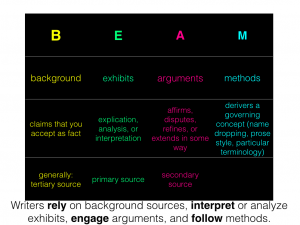Before reading a quite hilarious article on the most TERIBLE research account ever, I dove into my own head and mapped out my research process.
As you’ll see I believe organization of research during and before you even start is extremely important, and makes the process quicker, better, and honestly kind of fun…. like a game or puzzle!
1) creating an organized map (titles of sections, subtitles, etc) so I know exactly what I need to research
2) having 2-5 bullet points below each section on the main points I know I want or need to find out to put in this section (this could be from background research OR, if you are a better student, questions that you want answered)
3) starting journal research using JSTOR or Google Scholar, adding those URLs to each section’s bullet points
4) approaching each section’s research individually by printing out each jounral (unless excessively long), high lighting, then including the information in each section with, of course, proper citation
5) adding on – if after the reading there are sections I find I should include, then I add them in, this includes opposing views
Librarians have always scared me, and honestly every librarian I meet reminds me of this lady:

Source: Tumblr
BUT they are nice, and it’s their job to help you, so use them!
For now…. onto our next topic!

Source: WIfflegifs
I connected to Joseph Bizup’s report on BEAM: A Rhetorical Vocabulary for Teaching Research-Based Writing because of his emphasis on classifying the sources you use. He stressed that he wants students to “adopt a rhetorical perspective toward research-based writing” and through this, change how they “use them.” I have created a fun little BEAM cheat sheet below:

Source: LeslieAkin
As you can tell, I put a lot of stress on organization in my process of research… so I was immediately drawn to Bizup’s article. What’s more than organizing what I need to research (content wise), but also organizing what sources I have researched (classification)?! Sounds like heaven to me!
After organizing the sources, you can map out your plan for conversation between the sources. I remember this vividly in high school teachers saying “have conversations with your sources!”
Having conversations between your sources will make your piece flow (and feel less structured and middle-school book report like!) Bizup agrees with me when he states the relationships between each of the BEAM team: “If you start with an exhibit, look for argument sources to engage; if you start with argument sources, look for exhibits to interpret.”
Now if you ask me, I think I’ve summed up how I (and you!) can use BEAM to further my research! And therefore “use these “fruits” effectively.”

Source: Wifflegifs
End Side Note: not to mention his brief moment of stress on vocabulary… I specifically related to this because I feel I was not taught vocabulary enough in middle and high school, it was either assumed you knew the word or explained to you through a very simple, and often times over-simplified and thus incorrect, way. Bizup exclaims that through “relying on… everyday understanding of words to make initial sense… potentially misleads explanations” of terms.
